MGT100 - Organisation & Management: Cultural Movement Analysis
VerifiedAdded on 2023/06/13
|8
|2053
|288
Report
AI Summary
This report provides an analysis of an article discussing cultural change in organizations through a movement-based approach. It examines the authors' arguments, rationale, and supporting evidence, focusing on how leaders can learn from social movements to engage employees and foster innovation. The report also critiques the research methodology, highlighting its strengths and limitations, and explores the practical implications for organizational leaders. Additionally, it incorporates insights from MGT100 course material and references peer-reviewed articles to further support the analysis of organizational culture and change management. The report concludes by emphasizing the importance of employee involvement and addressing resistance to change in order to achieve successful cultural transformation.
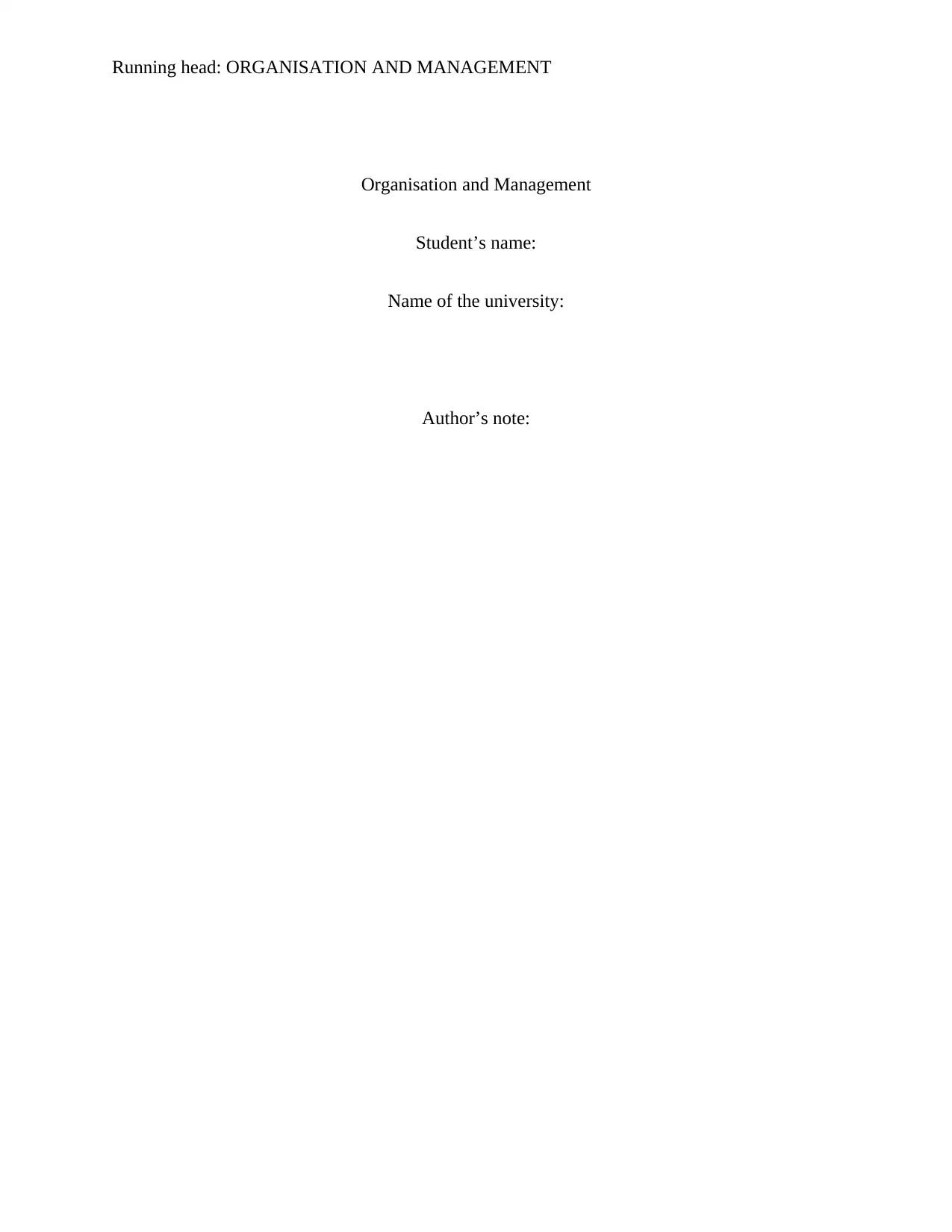
Running head: ORGANISATION AND MANAGEMENT
Organisation and Management
Student’s name:
Name of the university:
Author’s note:
Organisation and Management
Student’s name:
Name of the university:
Author’s note:
Paraphrase This Document
Need a fresh take? Get an instant paraphrase of this document with our AI Paraphraser
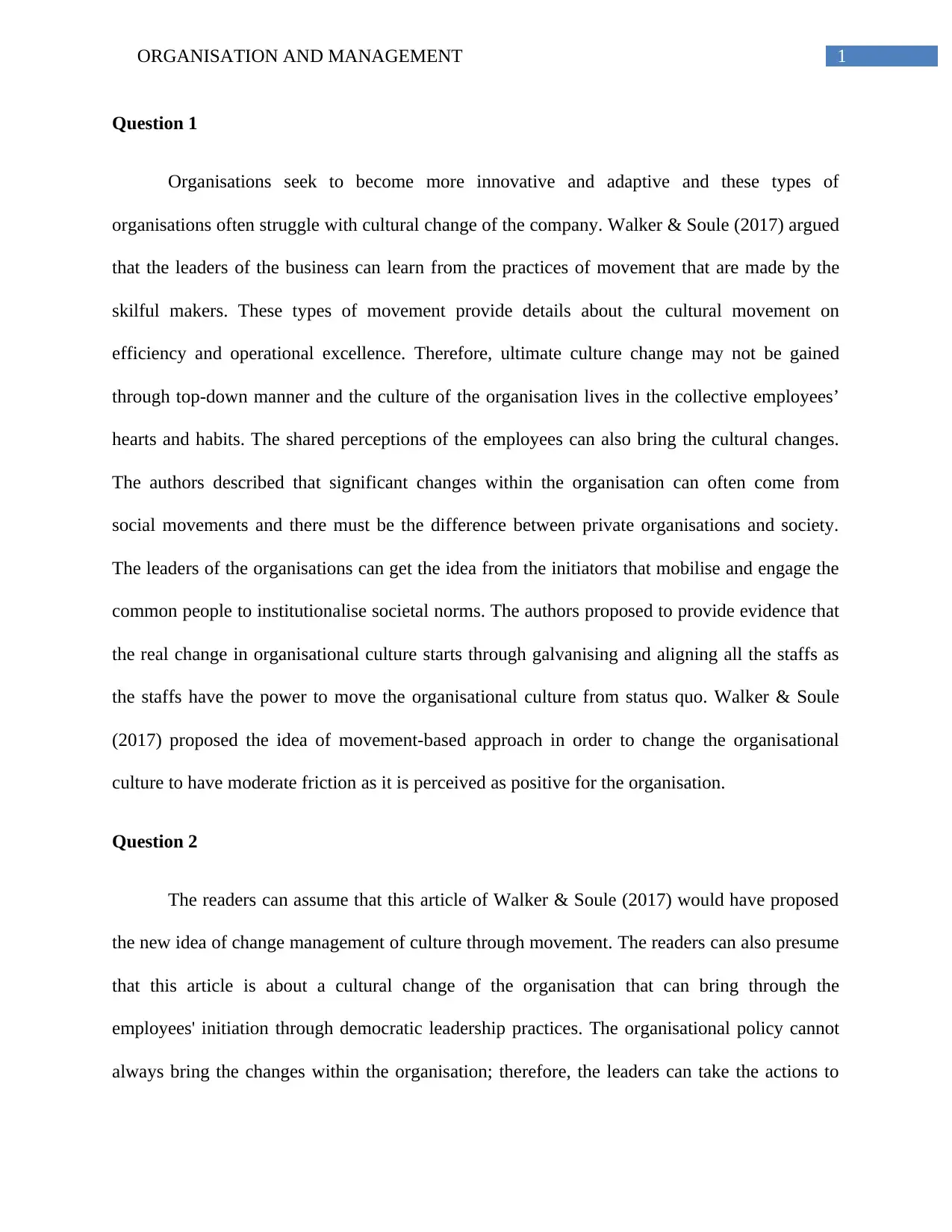
1ORGANISATION AND MANAGEMENT
Question 1
Organisations seek to become more innovative and adaptive and these types of
organisations often struggle with cultural change of the company. Walker & Soule (2017) argued
that the leaders of the business can learn from the practices of movement that are made by the
skilful makers. These types of movement provide details about the cultural movement on
efficiency and operational excellence. Therefore, ultimate culture change may not be gained
through top-down manner and the culture of the organisation lives in the collective employees’
hearts and habits. The shared perceptions of the employees can also bring the cultural changes.
The authors described that significant changes within the organisation can often come from
social movements and there must be the difference between private organisations and society.
The leaders of the organisations can get the idea from the initiators that mobilise and engage the
common people to institutionalise societal norms. The authors proposed to provide evidence that
the real change in organisational culture starts through galvanising and aligning all the staffs as
the staffs have the power to move the organisational culture from status quo. Walker & Soule
(2017) proposed the idea of movement-based approach in order to change the organisational
culture to have moderate friction as it is perceived as positive for the organisation.
Question 2
The readers can assume that this article of Walker & Soule (2017) would have proposed
the new idea of change management of culture through movement. The readers can also presume
that this article is about a cultural change of the organisation that can bring through the
employees' initiation through democratic leadership practices. The organisational policy cannot
always bring the changes within the organisation; therefore, the leaders can take the actions to
Question 1
Organisations seek to become more innovative and adaptive and these types of
organisations often struggle with cultural change of the company. Walker & Soule (2017) argued
that the leaders of the business can learn from the practices of movement that are made by the
skilful makers. These types of movement provide details about the cultural movement on
efficiency and operational excellence. Therefore, ultimate culture change may not be gained
through top-down manner and the culture of the organisation lives in the collective employees’
hearts and habits. The shared perceptions of the employees can also bring the cultural changes.
The authors described that significant changes within the organisation can often come from
social movements and there must be the difference between private organisations and society.
The leaders of the organisations can get the idea from the initiators that mobilise and engage the
common people to institutionalise societal norms. The authors proposed to provide evidence that
the real change in organisational culture starts through galvanising and aligning all the staffs as
the staffs have the power to move the organisational culture from status quo. Walker & Soule
(2017) proposed the idea of movement-based approach in order to change the organisational
culture to have moderate friction as it is perceived as positive for the organisation.
Question 2
The readers can assume that this article of Walker & Soule (2017) would have proposed
the new idea of change management of culture through movement. The readers can also presume
that this article is about a cultural change of the organisation that can bring through the
employees' initiation through democratic leadership practices. The organisational policy cannot
always bring the changes within the organisation; therefore, the leaders can take the actions to
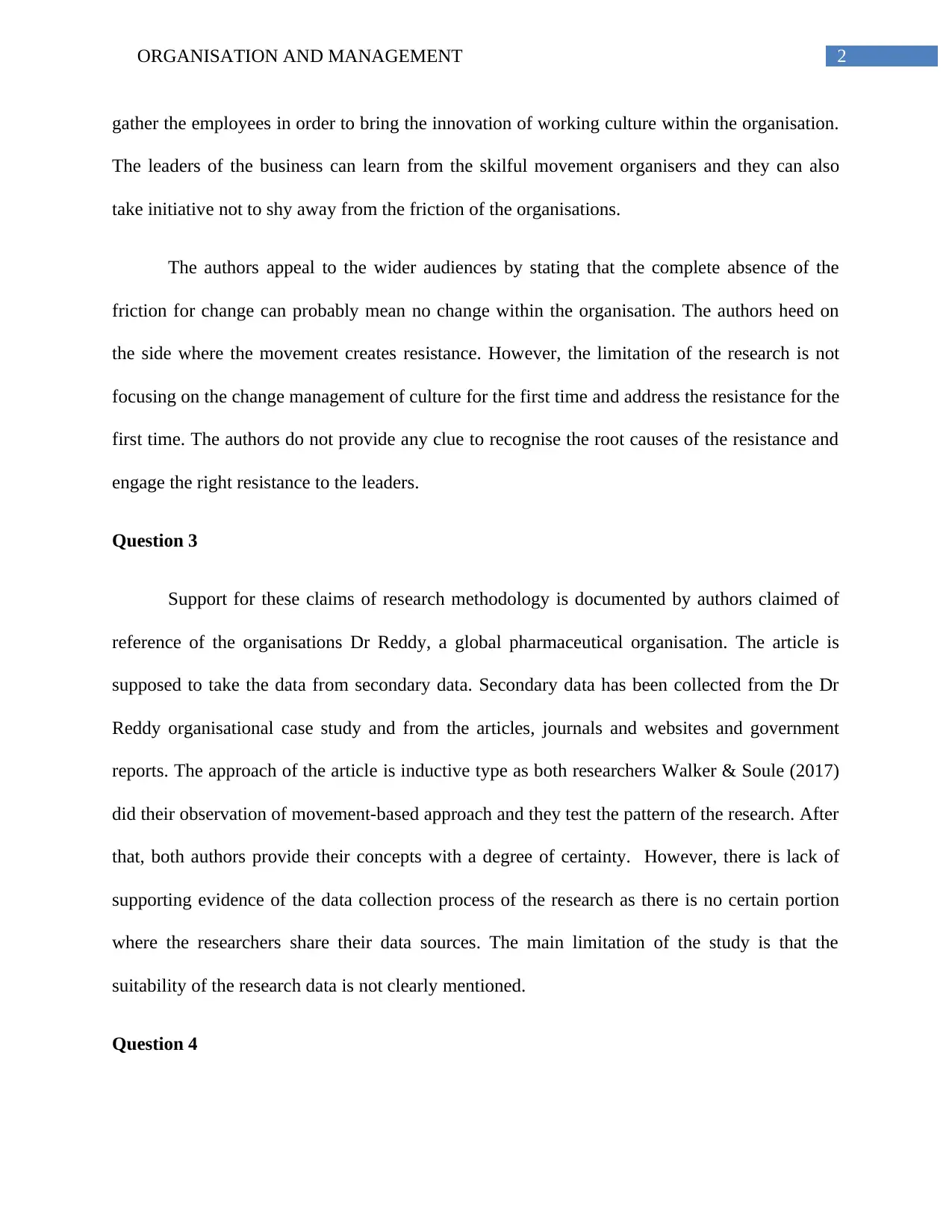
2ORGANISATION AND MANAGEMENT
gather the employees in order to bring the innovation of working culture within the organisation.
The leaders of the business can learn from the skilful movement organisers and they can also
take initiative not to shy away from the friction of the organisations.
The authors appeal to the wider audiences by stating that the complete absence of the
friction for change can probably mean no change within the organisation. The authors heed on
the side where the movement creates resistance. However, the limitation of the research is not
focusing on the change management of culture for the first time and address the resistance for the
first time. The authors do not provide any clue to recognise the root causes of the resistance and
engage the right resistance to the leaders.
Question 3
Support for these claims of research methodology is documented by authors claimed of
reference of the organisations Dr Reddy, a global pharmaceutical organisation. The article is
supposed to take the data from secondary data. Secondary data has been collected from the Dr
Reddy organisational case study and from the articles, journals and websites and government
reports. The approach of the article is inductive type as both researchers Walker & Soule (2017)
did their observation of movement-based approach and they test the pattern of the research. After
that, both authors provide their concepts with a degree of certainty. However, there is lack of
supporting evidence of the data collection process of the research as there is no certain portion
where the researchers share their data sources. The main limitation of the study is that the
suitability of the research data is not clearly mentioned.
Question 4
gather the employees in order to bring the innovation of working culture within the organisation.
The leaders of the business can learn from the skilful movement organisers and they can also
take initiative not to shy away from the friction of the organisations.
The authors appeal to the wider audiences by stating that the complete absence of the
friction for change can probably mean no change within the organisation. The authors heed on
the side where the movement creates resistance. However, the limitation of the research is not
focusing on the change management of culture for the first time and address the resistance for the
first time. The authors do not provide any clue to recognise the root causes of the resistance and
engage the right resistance to the leaders.
Question 3
Support for these claims of research methodology is documented by authors claimed of
reference of the organisations Dr Reddy, a global pharmaceutical organisation. The article is
supposed to take the data from secondary data. Secondary data has been collected from the Dr
Reddy organisational case study and from the articles, journals and websites and government
reports. The approach of the article is inductive type as both researchers Walker & Soule (2017)
did their observation of movement-based approach and they test the pattern of the research. After
that, both authors provide their concepts with a degree of certainty. However, there is lack of
supporting evidence of the data collection process of the research as there is no certain portion
where the researchers share their data sources. The main limitation of the study is that the
suitability of the research data is not clearly mentioned.
Question 4
⊘ This is a preview!⊘
Do you want full access?
Subscribe today to unlock all pages.

Trusted by 1+ million students worldwide
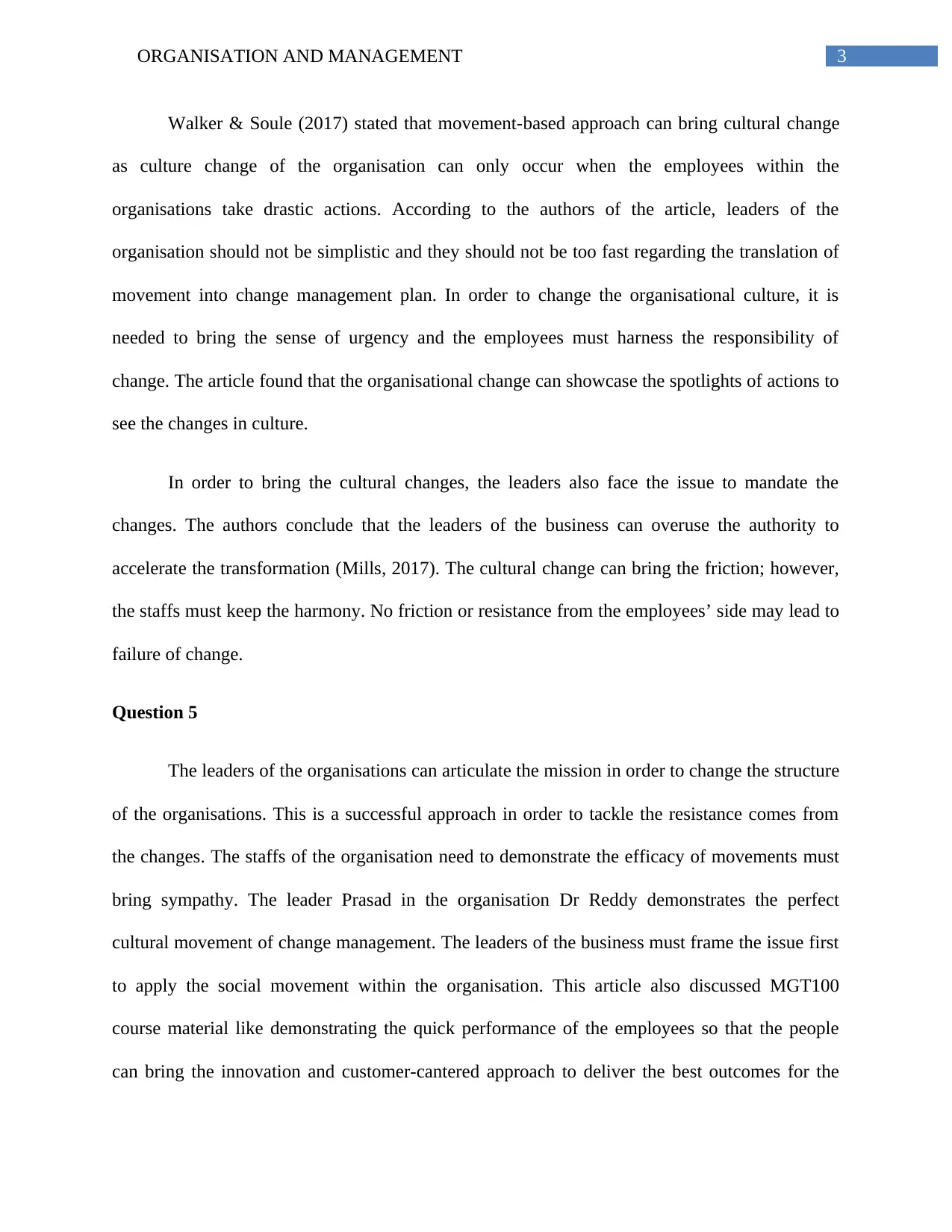
3ORGANISATION AND MANAGEMENT
Walker & Soule (2017) stated that movement-based approach can bring cultural change
as culture change of the organisation can only occur when the employees within the
organisations take drastic actions. According to the authors of the article, leaders of the
organisation should not be simplistic and they should not be too fast regarding the translation of
movement into change management plan. In order to change the organisational culture, it is
needed to bring the sense of urgency and the employees must harness the responsibility of
change. The article found that the organisational change can showcase the spotlights of actions to
see the changes in culture.
In order to bring the cultural changes, the leaders also face the issue to mandate the
changes. The authors conclude that the leaders of the business can overuse the authority to
accelerate the transformation (Mills, 2017). The cultural change can bring the friction; however,
the staffs must keep the harmony. No friction or resistance from the employees’ side may lead to
failure of change.
Question 5
The leaders of the organisations can articulate the mission in order to change the structure
of the organisations. This is a successful approach in order to tackle the resistance comes from
the changes. The staffs of the organisation need to demonstrate the efficacy of movements must
bring sympathy. The leader Prasad in the organisation Dr Reddy demonstrates the perfect
cultural movement of change management. The leaders of the business must frame the issue first
to apply the social movement within the organisation. This article also discussed MGT100
course material like demonstrating the quick performance of the employees so that the people
can bring the innovation and customer-cantered approach to deliver the best outcomes for the
Walker & Soule (2017) stated that movement-based approach can bring cultural change
as culture change of the organisation can only occur when the employees within the
organisations take drastic actions. According to the authors of the article, leaders of the
organisation should not be simplistic and they should not be too fast regarding the translation of
movement into change management plan. In order to change the organisational culture, it is
needed to bring the sense of urgency and the employees must harness the responsibility of
change. The article found that the organisational change can showcase the spotlights of actions to
see the changes in culture.
In order to bring the cultural changes, the leaders also face the issue to mandate the
changes. The authors conclude that the leaders of the business can overuse the authority to
accelerate the transformation (Mills, 2017). The cultural change can bring the friction; however,
the staffs must keep the harmony. No friction or resistance from the employees’ side may lead to
failure of change.
Question 5
The leaders of the organisations can articulate the mission in order to change the structure
of the organisations. This is a successful approach in order to tackle the resistance comes from
the changes. The staffs of the organisation need to demonstrate the efficacy of movements must
bring sympathy. The leader Prasad in the organisation Dr Reddy demonstrates the perfect
cultural movement of change management. The leaders of the business must frame the issue first
to apply the social movement within the organisation. This article also discussed MGT100
course material like demonstrating the quick performance of the employees so that the people
can bring the innovation and customer-cantered approach to deliver the best outcomes for the
Paraphrase This Document
Need a fresh take? Get an instant paraphrase of this document with our AI Paraphraser
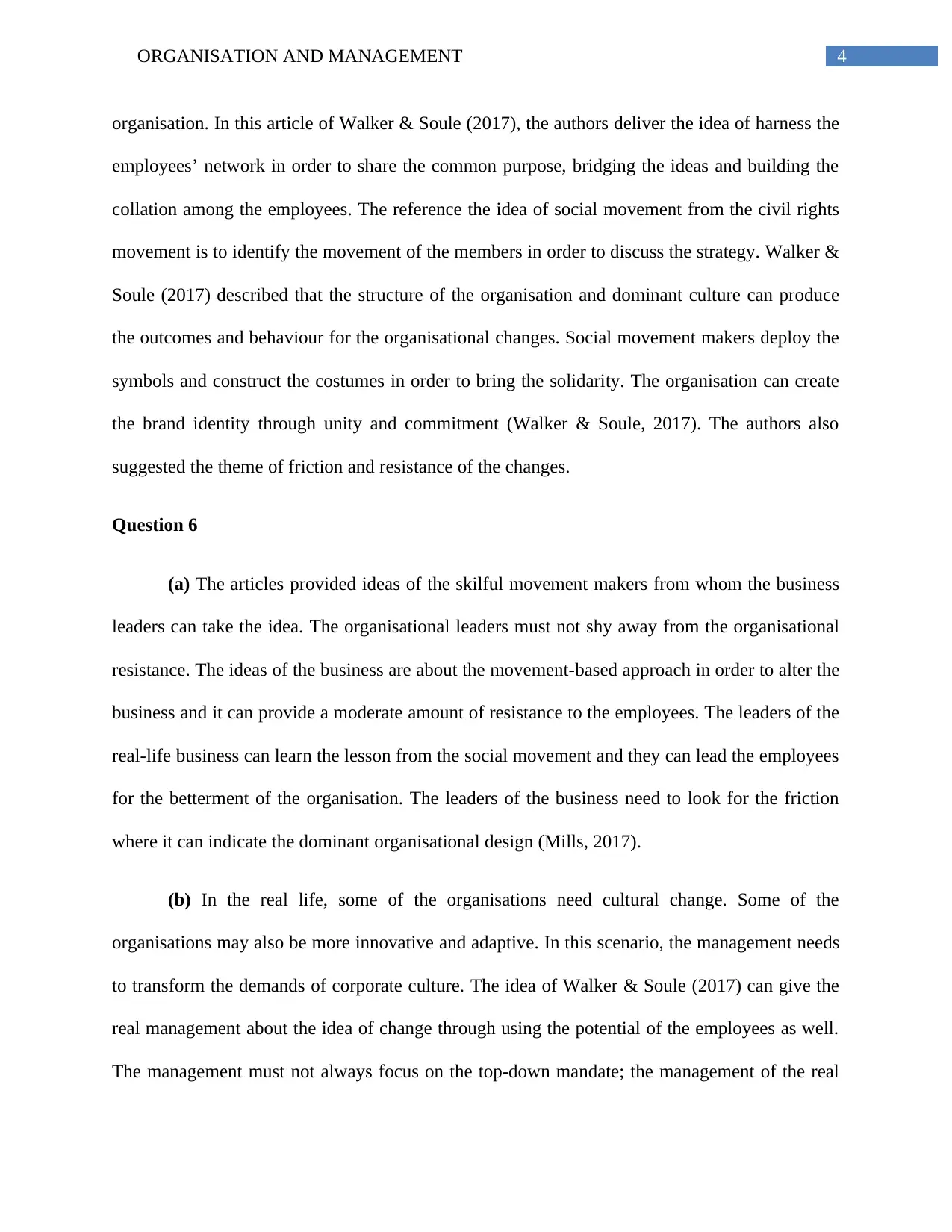
4ORGANISATION AND MANAGEMENT
organisation. In this article of Walker & Soule (2017), the authors deliver the idea of harness the
employees’ network in order to share the common purpose, bridging the ideas and building the
collation among the employees. The reference the idea of social movement from the civil rights
movement is to identify the movement of the members in order to discuss the strategy. Walker &
Soule (2017) described that the structure of the organisation and dominant culture can produce
the outcomes and behaviour for the organisational changes. Social movement makers deploy the
symbols and construct the costumes in order to bring the solidarity. The organisation can create
the brand identity through unity and commitment (Walker & Soule, 2017). The authors also
suggested the theme of friction and resistance of the changes.
Question 6
(a) The articles provided ideas of the skilful movement makers from whom the business
leaders can take the idea. The organisational leaders must not shy away from the organisational
resistance. The ideas of the business are about the movement-based approach in order to alter the
business and it can provide a moderate amount of resistance to the employees. The leaders of the
real-life business can learn the lesson from the social movement and they can lead the employees
for the betterment of the organisation. The leaders of the business need to look for the friction
where it can indicate the dominant organisational design (Mills, 2017).
(b) In the real life, some of the organisations need cultural change. Some of the
organisations may also be more innovative and adaptive. In this scenario, the management needs
to transform the demands of corporate culture. The idea of Walker & Soule (2017) can give the
real management about the idea of change through using the potential of the employees as well.
The management must not always focus on the top-down mandate; the management of the real
organisation. In this article of Walker & Soule (2017), the authors deliver the idea of harness the
employees’ network in order to share the common purpose, bridging the ideas and building the
collation among the employees. The reference the idea of social movement from the civil rights
movement is to identify the movement of the members in order to discuss the strategy. Walker &
Soule (2017) described that the structure of the organisation and dominant culture can produce
the outcomes and behaviour for the organisational changes. Social movement makers deploy the
symbols and construct the costumes in order to bring the solidarity. The organisation can create
the brand identity through unity and commitment (Walker & Soule, 2017). The authors also
suggested the theme of friction and resistance of the changes.
Question 6
(a) The articles provided ideas of the skilful movement makers from whom the business
leaders can take the idea. The organisational leaders must not shy away from the organisational
resistance. The ideas of the business are about the movement-based approach in order to alter the
business and it can provide a moderate amount of resistance to the employees. The leaders of the
real-life business can learn the lesson from the social movement and they can lead the employees
for the betterment of the organisation. The leaders of the business need to look for the friction
where it can indicate the dominant organisational design (Mills, 2017).
(b) In the real life, some of the organisations need cultural change. Some of the
organisations may also be more innovative and adaptive. In this scenario, the management needs
to transform the demands of corporate culture. The idea of Walker & Soule (2017) can give the
real management about the idea of change through using the potential of the employees as well.
The management must not always focus on the top-down mandate; the management of the real
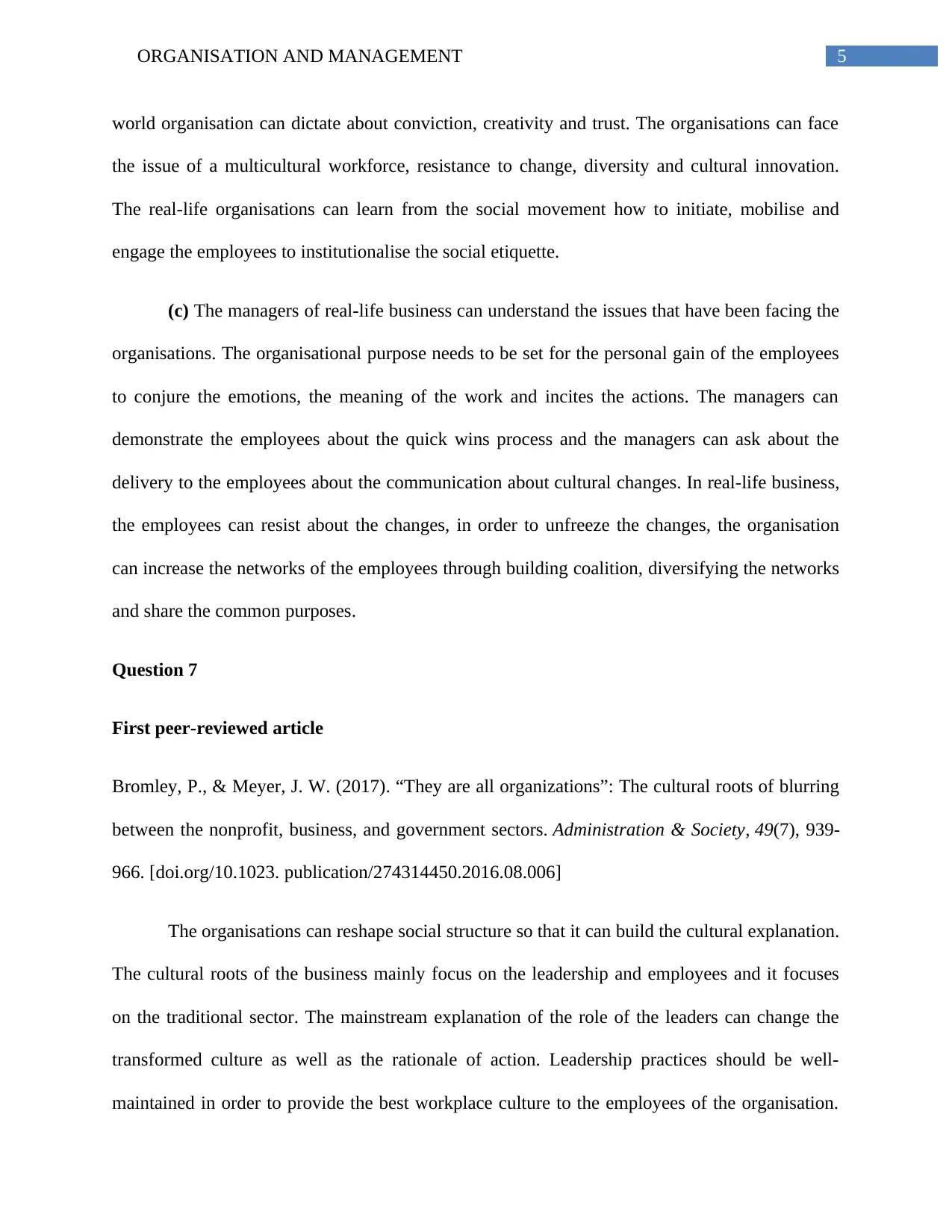
5ORGANISATION AND MANAGEMENT
world organisation can dictate about conviction, creativity and trust. The organisations can face
the issue of a multicultural workforce, resistance to change, diversity and cultural innovation.
The real-life organisations can learn from the social movement how to initiate, mobilise and
engage the employees to institutionalise the social etiquette.
(c) The managers of real-life business can understand the issues that have been facing the
organisations. The organisational purpose needs to be set for the personal gain of the employees
to conjure the emotions, the meaning of the work and incites the actions. The managers can
demonstrate the employees about the quick wins process and the managers can ask about the
delivery to the employees about the communication about cultural changes. In real-life business,
the employees can resist about the changes, in order to unfreeze the changes, the organisation
can increase the networks of the employees through building coalition, diversifying the networks
and share the common purposes.
Question 7
First peer-reviewed article
Bromley, P., & Meyer, J. W. (2017). “They are all organizations”: The cultural roots of blurring
between the nonprofit, business, and government sectors. Administration & Society, 49(7), 939-
966. [doi.org/10.1023. publication/274314450.2016.08.006]
The organisations can reshape social structure so that it can build the cultural explanation.
The cultural roots of the business mainly focus on the leadership and employees and it focuses
on the traditional sector. The mainstream explanation of the role of the leaders can change the
transformed culture as well as the rationale of action. Leadership practices should be well-
maintained in order to provide the best workplace culture to the employees of the organisation.
world organisation can dictate about conviction, creativity and trust. The organisations can face
the issue of a multicultural workforce, resistance to change, diversity and cultural innovation.
The real-life organisations can learn from the social movement how to initiate, mobilise and
engage the employees to institutionalise the social etiquette.
(c) The managers of real-life business can understand the issues that have been facing the
organisations. The organisational purpose needs to be set for the personal gain of the employees
to conjure the emotions, the meaning of the work and incites the actions. The managers can
demonstrate the employees about the quick wins process and the managers can ask about the
delivery to the employees about the communication about cultural changes. In real-life business,
the employees can resist about the changes, in order to unfreeze the changes, the organisation
can increase the networks of the employees through building coalition, diversifying the networks
and share the common purposes.
Question 7
First peer-reviewed article
Bromley, P., & Meyer, J. W. (2017). “They are all organizations”: The cultural roots of blurring
between the nonprofit, business, and government sectors. Administration & Society, 49(7), 939-
966. [doi.org/10.1023. publication/274314450.2016.08.006]
The organisations can reshape social structure so that it can build the cultural explanation.
The cultural roots of the business mainly focus on the leadership and employees and it focuses
on the traditional sector. The mainstream explanation of the role of the leaders can change the
transformed culture as well as the rationale of action. Leadership practices should be well-
maintained in order to provide the best workplace culture to the employees of the organisation.
⊘ This is a preview!⊘
Do you want full access?
Subscribe today to unlock all pages.

Trusted by 1+ million students worldwide
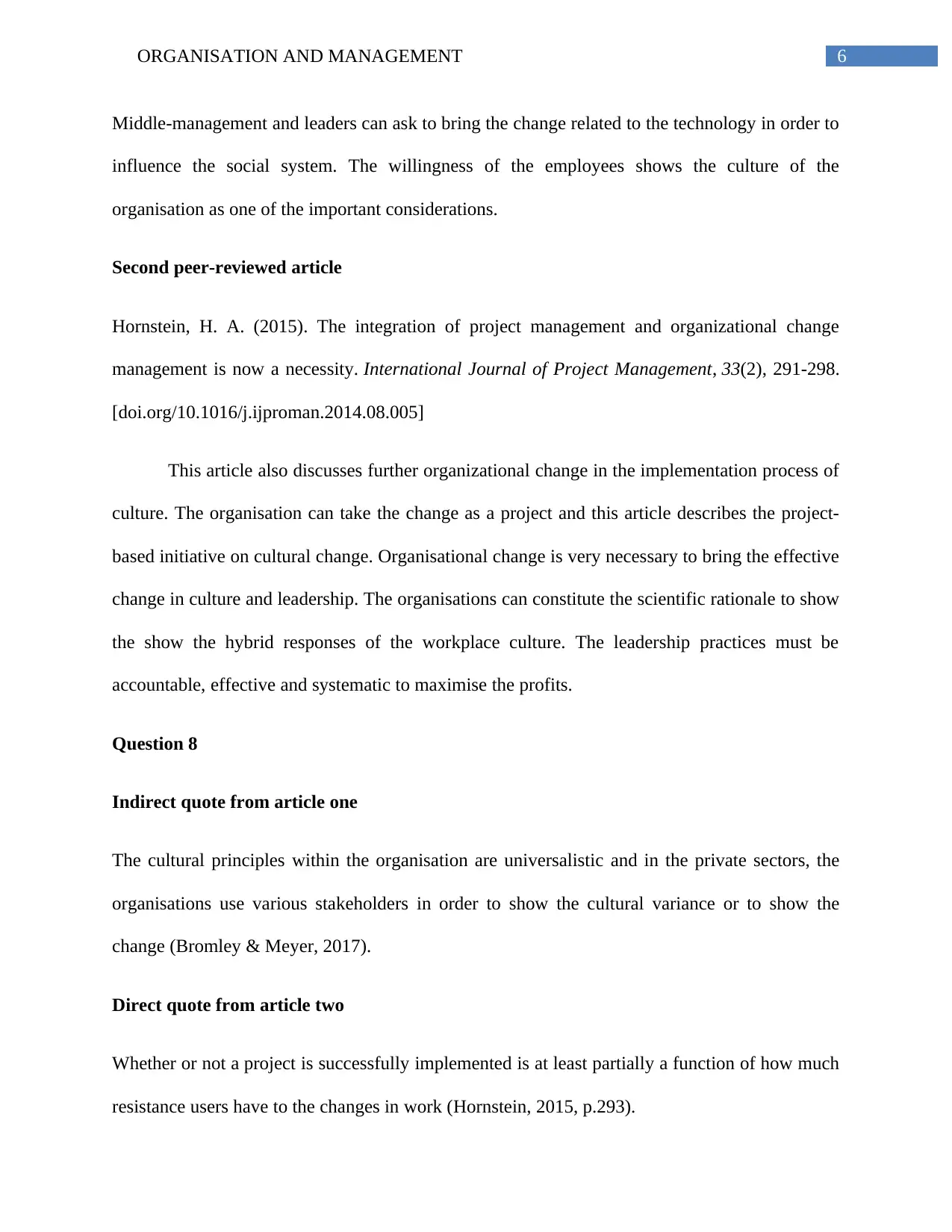
6ORGANISATION AND MANAGEMENT
Middle-management and leaders can ask to bring the change related to the technology in order to
influence the social system. The willingness of the employees shows the culture of the
organisation as one of the important considerations.
Second peer-reviewed article
Hornstein, H. A. (2015). The integration of project management and organizational change
management is now a necessity. International Journal of Project Management, 33(2), 291-298.
[doi.org/10.1016/j.ijproman.2014.08.005]
This article also discusses further organizational change in the implementation process of
culture. The organisation can take the change as a project and this article describes the project-
based initiative on cultural change. Organisational change is very necessary to bring the effective
change in culture and leadership. The organisations can constitute the scientific rationale to show
the show the hybrid responses of the workplace culture. The leadership practices must be
accountable, effective and systematic to maximise the profits.
Question 8
Indirect quote from article one
The cultural principles within the organisation are universalistic and in the private sectors, the
organisations use various stakeholders in order to show the cultural variance or to show the
change (Bromley & Meyer, 2017).
Direct quote from article two
Whether or not a project is successfully implemented is at least partially a function of how much
resistance users have to the changes in work (Hornstein, 2015, p.293).
Middle-management and leaders can ask to bring the change related to the technology in order to
influence the social system. The willingness of the employees shows the culture of the
organisation as one of the important considerations.
Second peer-reviewed article
Hornstein, H. A. (2015). The integration of project management and organizational change
management is now a necessity. International Journal of Project Management, 33(2), 291-298.
[doi.org/10.1016/j.ijproman.2014.08.005]
This article also discusses further organizational change in the implementation process of
culture. The organisation can take the change as a project and this article describes the project-
based initiative on cultural change. Organisational change is very necessary to bring the effective
change in culture and leadership. The organisations can constitute the scientific rationale to show
the show the hybrid responses of the workplace culture. The leadership practices must be
accountable, effective and systematic to maximise the profits.
Question 8
Indirect quote from article one
The cultural principles within the organisation are universalistic and in the private sectors, the
organisations use various stakeholders in order to show the cultural variance or to show the
change (Bromley & Meyer, 2017).
Direct quote from article two
Whether or not a project is successfully implemented is at least partially a function of how much
resistance users have to the changes in work (Hornstein, 2015, p.293).
Paraphrase This Document
Need a fresh take? Get an instant paraphrase of this document with our AI Paraphraser
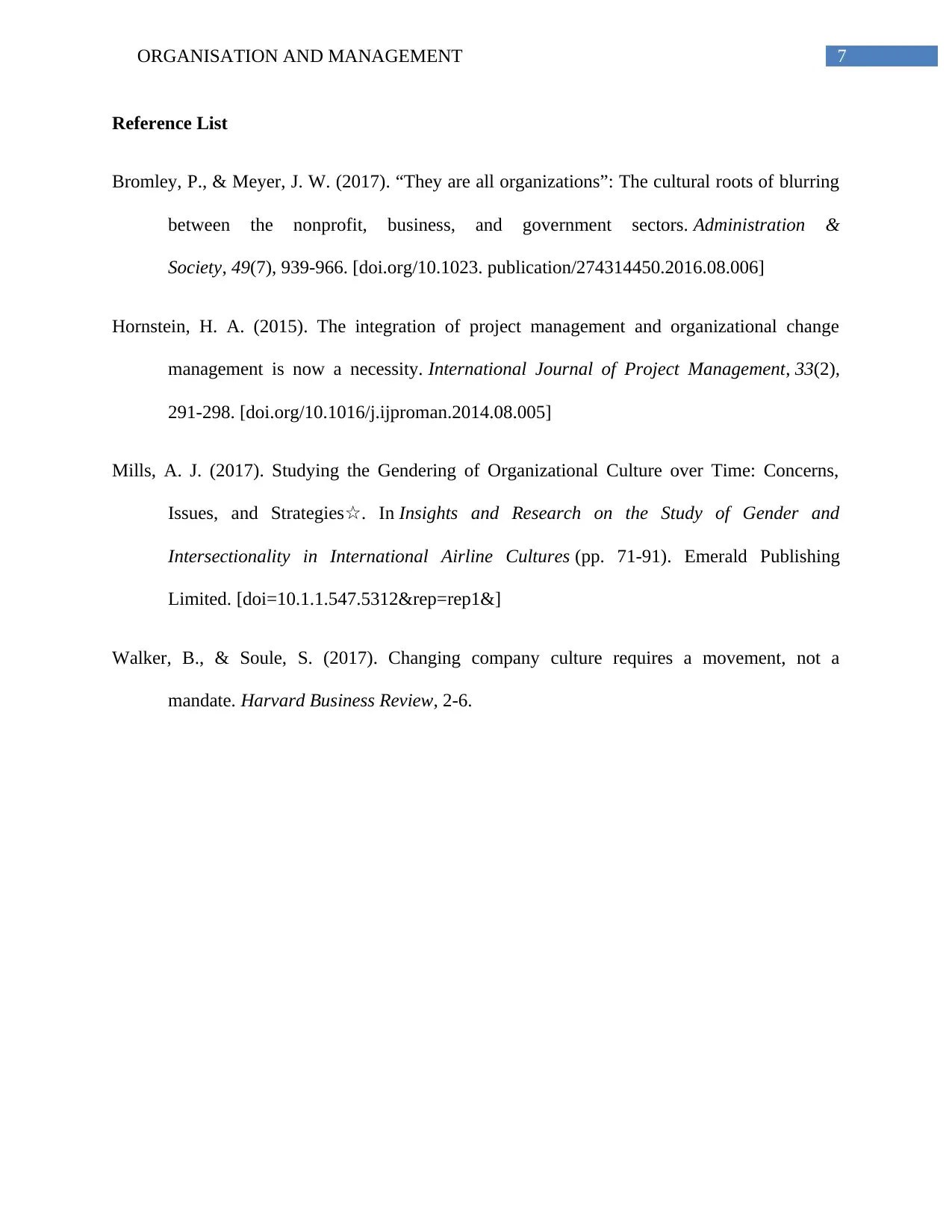
7ORGANISATION AND MANAGEMENT
Reference List
Bromley, P., & Meyer, J. W. (2017). “They are all organizations”: The cultural roots of blurring
between the nonprofit, business, and government sectors. Administration &
Society, 49(7), 939-966. [doi.org/10.1023. publication/274314450.2016.08.006]
Hornstein, H. A. (2015). The integration of project management and organizational change
management is now a necessity. International Journal of Project Management, 33(2),
291-298. [doi.org/10.1016/j.ijproman.2014.08.005]
Mills, A. J. (2017). Studying the Gendering of Organizational Culture over Time: Concerns,
Issues, and Strategies☆. In Insights and Research on the Study of Gender and
Intersectionality in International Airline Cultures (pp. 71-91). Emerald Publishing
Limited. [doi=10.1.1.547.5312&rep=rep1&]
Walker, B., & Soule, S. (2017). Changing company culture requires a movement, not a
mandate. Harvard Business Review, 2-6.
Reference List
Bromley, P., & Meyer, J. W. (2017). “They are all organizations”: The cultural roots of blurring
between the nonprofit, business, and government sectors. Administration &
Society, 49(7), 939-966. [doi.org/10.1023. publication/274314450.2016.08.006]
Hornstein, H. A. (2015). The integration of project management and organizational change
management is now a necessity. International Journal of Project Management, 33(2),
291-298. [doi.org/10.1016/j.ijproman.2014.08.005]
Mills, A. J. (2017). Studying the Gendering of Organizational Culture over Time: Concerns,
Issues, and Strategies☆. In Insights and Research on the Study of Gender and
Intersectionality in International Airline Cultures (pp. 71-91). Emerald Publishing
Limited. [doi=10.1.1.547.5312&rep=rep1&]
Walker, B., & Soule, S. (2017). Changing company culture requires a movement, not a
mandate. Harvard Business Review, 2-6.
1 out of 8
Related Documents
Your All-in-One AI-Powered Toolkit for Academic Success.
+13062052269
info@desklib.com
Available 24*7 on WhatsApp / Email
![[object Object]](/_next/static/media/star-bottom.7253800d.svg)
Unlock your academic potential
Copyright © 2020–2025 A2Z Services. All Rights Reserved. Developed and managed by ZUCOL.





